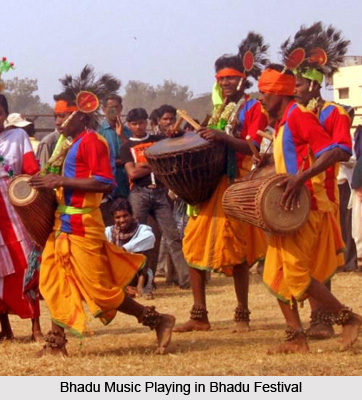 Bhadu music is a similar rural festival like Tusu and is depicted on a different subject in songs of the deity. Bhadu Devi of Manbhum. It takes place in the after-month of the rainy season i.e. the month of Bhadra. The ceremony is generally performed by young maidens of Purulia district, western Burdwan district and southern Birbhum district in the Indian state of West Bengal. But its popularity is extended to other regions, and participation of general people in it is one of its remarkable features. The wider participation of the common folk proves that the item is not confined to mere worship of a deity, but is connected in some way with the household welfare of agriculturists in general. In fact, it is in the name of the deity that the entire community prepares for a session of Bhadu music.
Bhadu music is a similar rural festival like Tusu and is depicted on a different subject in songs of the deity. Bhadu Devi of Manbhum. It takes place in the after-month of the rainy season i.e. the month of Bhadra. The ceremony is generally performed by young maidens of Purulia district, western Burdwan district and southern Birbhum district in the Indian state of West Bengal. But its popularity is extended to other regions, and participation of general people in it is one of its remarkable features. The wider participation of the common folk proves that the item is not confined to mere worship of a deity, but is connected in some way with the household welfare of agriculturists in general. In fact, it is in the name of the deity that the entire community prepares for a session of Bhadu music.
Tradition says that the idol-like daughter of the Raja of Panchakot passed away suddenly plunging the people of the entire region in bereavement. In course of time, she was converted into a deity named Bhadu and was made the object of worship by the people. Formalities for the worship, methods of rites and rituals, grew up subsequently. The festival starts from the last day of the second rainy month, i.e., the Sravan Sankranti day, and continues up to the Durga Puja in the month of October. The image of Bhadu is placed in a corner of the house where children congregate and sing the invocation song.
The song generally contains eulogies of parents and brothers, the married women speak of their fathers-in-law, and the unmarried ones extol their own home members. From medieval literature we know that generally rural married women were not treated well by their mothers-in-law, and they carried complaints to this effect to Bhadu deity.
In the close quarters of hearth and home Bhadu is offered sweets and clothing in a gay mood, and the theme of songs covers ideas of separation, pathos, demands for household needs, complaints of married daughters, etc. Bhadu treats everyday problems of life which are presented in the Pancali form of composition. The subject matter of Bhadu songs, as available in collections now-a-days, proves to be more reasonable, since it deals with mythological episode from the Ramayana and also with contemporary topics. Thus, in the modern theme of Bhadu, composed of a variety of subjects, a few variations in tunes also occur; peculiarities in form are not, however, comparable with any of the tunes of other streams. Musical compositions indicate bilawal and khamaj as the scales. A few tunes of Birbhum seem to correspond with the formation of music phrases and tunes of Bihar. Bhadu of Purulia appears to be influenced by Jhumur. Both Bhadu and Jhumur used to be performed by males. Bhadu of Purulia and Bankura districts used to be accompanied by dances of unmarried girls in the past. On a lower social level, among Bauris, this dance was participated in by both sexes, and the nature of performance was often considered as indifferent in taste.




















